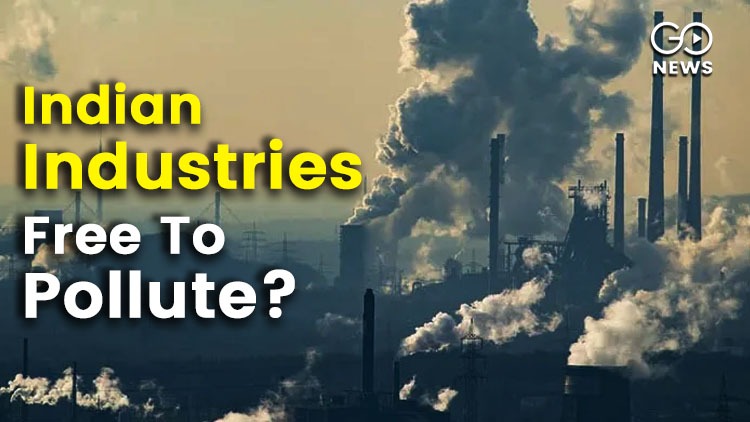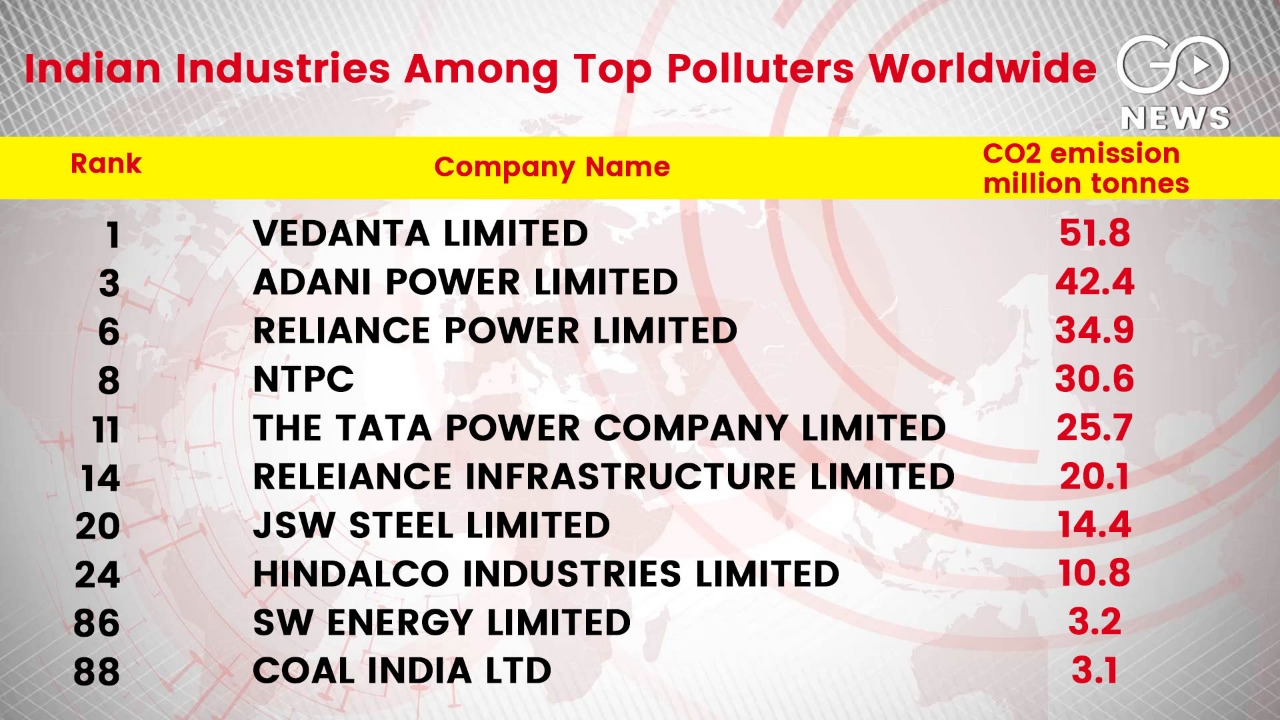12 Indian Companies Among Top 100 Co2 Polluters Globally

Indian companies feature 12 times in the list of top 100 most polluting companies of the world. The first spot is held by India’s Vedanta Limited that has a total market capitalization of ₹113,058 crore. It is a mining company that has often been at the focal point of land disputes with Adivasi communities in the mineral-rich areas of Chattisgarh and Jharkhand. One of the reasons it has been criticized, along with other businesses in the industry, is the pollution of local resources and environments that its operations entail.

Following Vedanta in the list are Adani Power Ltd (Rank 3), Reliance Power Ltd. (Rank 6), NTPC Ltd. (Rank 8), Tata Power Co. Ltd. (Rank 11), JSW Steel Ltd. (Rank 20), and Hindalco Industries Ltd. (Rank 24). This makes seven Indian companies within the top 25 polluters of the world. All these companies are private enterprises. The Tata Group and JSW Steel are one of the top political contributors from 2018-20. Bloomberg Quint used a report by Association For Democratic Reforms (ADR) to show JSW Steel as the highest door to electoral trusts in FY 2020 with ₹39.1 crore. Tata Group’s Progressive Electoral Trust gave 75% of the BJP’s total income from bonds in FY 2018-19, as notified by the Election Commission.
The Centre For Policy Research observed in 2019 that environmental regulatory mechanisms face major problems with compliance and implementation. India Spend analyzed reports and data from 2014 to 2017 to show how governments at the state and Central levels diluted environmental regulations, in a scenario wherein they were already lax.
State Pollution Control Boards have exempted 146 out of 206 polluting industries from routine inspection. Instead, they can opt for “self-monitoring” and third-party certifications. The Centre’s BRAPs (Business reform Action Plans) which have been implemented since 2014 effectively incentivize states to lessen the environmental protections regarding industries.
The brunt of rapid, unregulated industrialization in the name of development is borne by the public in various ways. Local, Adivasi communities are forcibly displaced and/or live in substandard conditions due to pollution of the local environment and livelihood sources. India has 10 of the world’s top 20 most polluted cities, and Indians are exposed to one of the highest rates of air toxicity in the world, according to the World Health Organization (WHO).
The Observer Research Foundation (ORF) ha quoted a variety of sources to illustrate the severity of the pollution crisis in India:
• The Health Effects Institute says that in 2015, over 1.1 million deaths were caused in India due to air pollution.
• 18% of all deaths in India were caused by air pollution in 2019
• In 2020, India ranked 3rd in the world’s most polluted countries according to IQAir The ORF states a point that has often been made regarding India’s pollution control efforts: “Governments have initiated policy initiatives and created regulatory agencies and other institutions all meant to combat air pollution; they are highly inadequate”.
There was public backlash against the draft EIA notifications last year, which included among other things, the contentious issue of “post facto clearance”. It assumes that industries that have violated environmental rules did so out of “ignorance” and not willful cognizance and self-interest. In April 2020, the Supreme Court had observed: “The concept of an ex post facto EC (environmental clearance) is in derogation of the fundamental principles of environmental jurisprudence and is an anathema to the EIA notification dated 27 January 1994. It is, as the judgment in Common Cause holds, detrimental to the environment and could lead to irreparable degradation."
The EIA notification galvanized activists and civil society against the idea of unhindered ‘developmental’ activities at the cost of sustainability, and public health and participation. It remains to be seen whether and how India will rein in its polluting industries for the larger public good.

Following Vedanta in the list are Adani Power Ltd (Rank 3), Reliance Power Ltd. (Rank 6), NTPC Ltd. (Rank 8), Tata Power Co. Ltd. (Rank 11), JSW Steel Ltd. (Rank 20), and Hindalco Industries Ltd. (Rank 24). This makes seven Indian companies within the top 25 polluters of the world. All these companies are private enterprises. The Tata Group and JSW Steel are one of the top political contributors from 2018-20. Bloomberg Quint used a report by Association For Democratic Reforms (ADR) to show JSW Steel as the highest door to electoral trusts in FY 2020 with ₹39.1 crore. Tata Group’s Progressive Electoral Trust gave 75% of the BJP’s total income from bonds in FY 2018-19, as notified by the Election Commission.
The Centre For Policy Research observed in 2019 that environmental regulatory mechanisms face major problems with compliance and implementation. India Spend analyzed reports and data from 2014 to 2017 to show how governments at the state and Central levels diluted environmental regulations, in a scenario wherein they were already lax.
State Pollution Control Boards have exempted 146 out of 206 polluting industries from routine inspection. Instead, they can opt for “self-monitoring” and third-party certifications. The Centre’s BRAPs (Business reform Action Plans) which have been implemented since 2014 effectively incentivize states to lessen the environmental protections regarding industries.
The brunt of rapid, unregulated industrialization in the name of development is borne by the public in various ways. Local, Adivasi communities are forcibly displaced and/or live in substandard conditions due to pollution of the local environment and livelihood sources. India has 10 of the world’s top 20 most polluted cities, and Indians are exposed to one of the highest rates of air toxicity in the world, according to the World Health Organization (WHO).
The Observer Research Foundation (ORF) ha quoted a variety of sources to illustrate the severity of the pollution crisis in India:
• The Health Effects Institute says that in 2015, over 1.1 million deaths were caused in India due to air pollution.
• 18% of all deaths in India were caused by air pollution in 2019
• In 2020, India ranked 3rd in the world’s most polluted countries according to IQAir The ORF states a point that has often been made regarding India’s pollution control efforts: “Governments have initiated policy initiatives and created regulatory agencies and other institutions all meant to combat air pollution; they are highly inadequate”.
There was public backlash against the draft EIA notifications last year, which included among other things, the contentious issue of “post facto clearance”. It assumes that industries that have violated environmental rules did so out of “ignorance” and not willful cognizance and self-interest. In April 2020, the Supreme Court had observed: “The concept of an ex post facto EC (environmental clearance) is in derogation of the fundamental principles of environmental jurisprudence and is an anathema to the EIA notification dated 27 January 1994. It is, as the judgment in Common Cause holds, detrimental to the environment and could lead to irreparable degradation."
The EIA notification galvanized activists and civil society against the idea of unhindered ‘developmental’ activities at the cost of sustainability, and public health and participation. It remains to be seen whether and how India will rein in its polluting industries for the larger public good.
Latest Videos
















